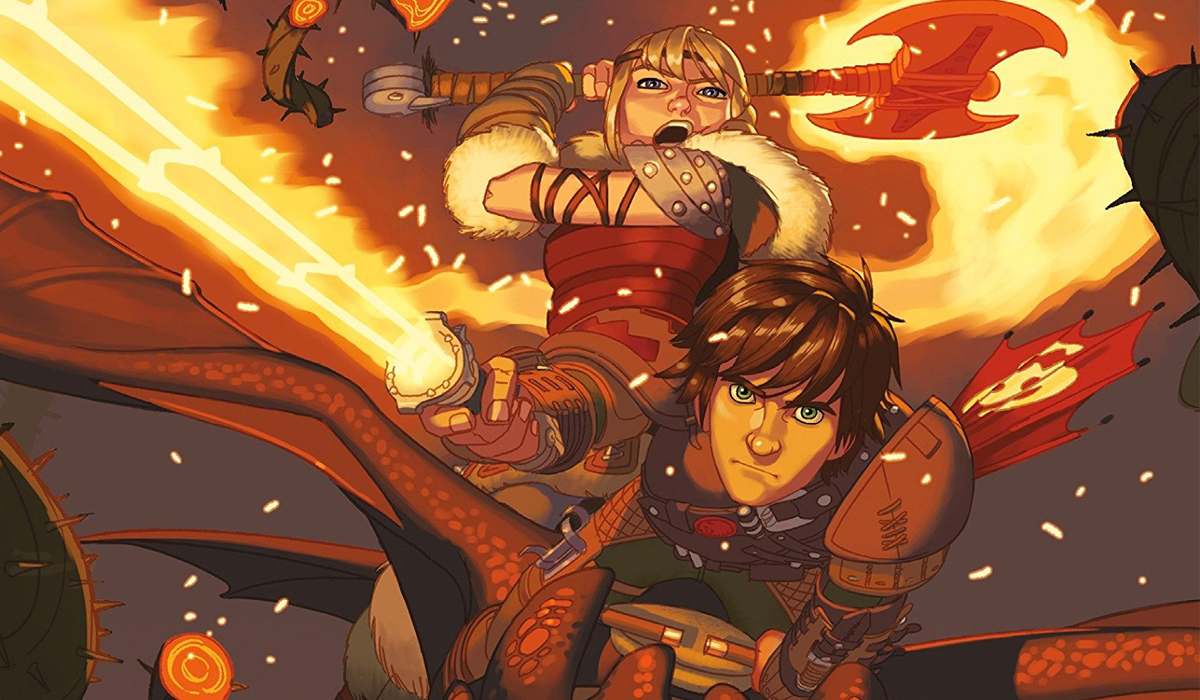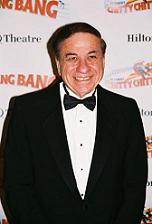 Based on the popular children’s stories by P.L. Travers, Mary Poppins has won the hearts of generations of kids and their parents with its enchanting tale of a magical nanny who changes the lives of two rowdy but neglected kids with determination, discipline and just “a spoonful of sugar.”
Based on the popular children’s stories by P.L. Travers, Mary Poppins has won the hearts of generations of kids and their parents with its enchanting tale of a magical nanny who changes the lives of two rowdy but neglected kids with determination, discipline and just “a spoonful of sugar.”
Mary Poppins takes Jane and Michael Banks on magical, musical outings including a play date with adorable animated penguins, a race through the country side on merry-go-round horses and a trip across the rooftops of London on a stairway made of smoke — and always gets them home in time for dinner! With her foolproof mixture of good manners and unpredictable fun, Mary not only introduces order to the chaotic Banks household, but brings the whole family together in the process.
With its revolutionary blend of live action and pioneering Disney animation, Mary Poppins became an instant hit and was nominated for the Best Picture Oscar. But the success of the film also lies in the hand of Walt Disney’s only staff-songwriters, the Sherman Brothers, who received Oscars for Best Song (Chim Chim Cher-ee), and Best Score.
Indeed, not only did they compose some of the most unforgettable and most loveable numbers for the film, such as Supercalifragilisticexpialidocious, A Spoonful of Sugar, Step in Time, Let’s Go Fly a Kite and the most beloved Feed the Birds (Tuppence a Bag), but they really were at the core of the project, being also involved in the story process. The result is a practically perfect Disney film in every way, and it is our pleasure to talk about it with one of its creators, Mr. Richard M. Sherman himself.
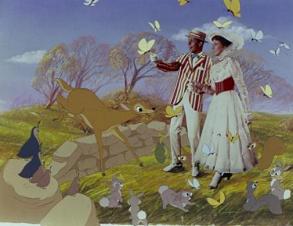
 Animated Views: To you, Mr. Sherman, what makes Mary Poppins so “practically perfect”?
Animated Views: To you, Mr. Sherman, what makes Mary Poppins so “practically perfect”?
Richard M. Sherman: Well, it’s a combination of a lot of things. First of all, we got to Disney because of our ideas for doing Poppins. If you have ever read the original stories, they take place in the thirties, they don’t take place at the turn of the century. There is no storyline not so ever in any of the Poppins books. They’re all about wonderful characters and wonderful incidents, little chapters and little adventures. And what we did was my brother Bob and I wove six chapters that we thought we very good and made a basic storyline. And Walt Disney liked the way we thought storywise, along with the ideas that we came up with: to make it a turn of the century piece because we had thought of the wonderful, colorful character of English musical style songs, vaudeville-type songs. Walt really enjoyed that idea. That’s when he put us on staff, and we became his staff-writers. That was four years before the picture ever came out.
So, we were working on picture after picture, television show after television show, while we were working on Poppins so we had a chance to really perfect things. When we had a sequence that Walt didn’t feel was necessary, we just had lost three months of work. And finally, when we got it in a pretty good shape, he put his top-scriptwriter, Bill Walsh, on it and we were also working all the time with Don Da Gradi, who was a brilliant storyman. So, between Walsh and Da Gradi, and Walt Disney of course, we had a great script. So, the script was so polished. It was three and a half years of sweat before we actually had it. Then, we finally made the film. Walt Disney put his entire bag of tricks, all these magical things that could be done in photography called sodium matte process, where you could put people into an animated film without any halos around their heads and everything. The old way, it was always obvious, but this way you just believed in these people in this chalk world. All that stuff was done with the top people in the industry; Disney’s geniuses were working on this things.
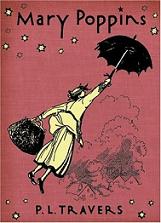 AV: How did you get along with them?
AV: How did you get along with them?
RMS: When we first came on the lot, in 1960, we were writing popular songs prior to that, and then we did this outline of how we thought a musical could be made of Mary Poppins, and Walt liked that very much. So, he hired us as his staff-songwriters. And the first day we were there, he said: “I want you to meet someone and talk about developing this Poppins idea with a brilliant guy. He’s a marvelous artist and also a great story construction man named Don Da Gradi.” Now, Don started out as an animator and then he became a storyman with the animation department. His artistic talent and story technique was such as he could draw and you could visualize exactely what he was talking about. So, we had them climbing up a smoke staircase and he created that smoke staircase. You could see it. He was an incredible help.
For the first two and a half to three years that we were on the Poppins project, which was like one day every two weeks, or sometimes two days or three days in a row when he wasn’t busy doing his stuff and we were busy doing ours, we worked with him, and Walt would come in and see the progress we were making. At a certain point in time, we met with this brilliant comedy writer and producer named Bill Walsh. He was the #1 writer/producer on the lot. He did Absent-Minded Professor. He was just a fantastic writer. He created the Love Boat pictures later and did wonderful pictures for Disney. Once in a while, he would come in and listen to what were doing and said: “that’s good, boys!”, but he never worked with us until one day, Walt said: “I think we now have our storyline. We need to really start writing and putting it down on paper because I want to get Mrs. Travers, the author, to give us a go-ahead to make it.”
Because he didn’t quite had a 100% authorization to make a film. He just had the right to develop it. So, Bill Walsh was put on it, and by the time Bill Walsh was on the picture, he started adding things like the run on the bank. That whole thing was Bill Walsh’s. He came up with the idea of the catastrophe when they want to take the tuppence from the little boy and put it in the bank to invest it. This was all Bill. “You have to have a crisis. And this is crisis. He gets fired”. It was a great plus. And so, Bill wrote the dialog.
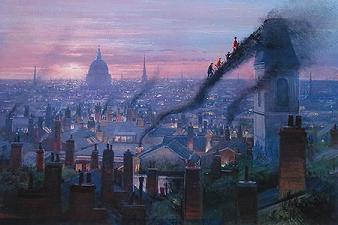
AV: And what kind of an involvement was Walt’s?
RMS: Walt was the most hands-on producer in the world. He was involved in every inch of that picture. Everything was okayed by him or thrown away by him. Any writer would tell you that the eraser’s the most active part of your writing, because then you’re eliminating, and keeping the best. So, Mary Poppins was a combination of Bill Walsh’s wit and style with word, Don Da Gradi’s visual genius, Walt Disney’s storytelling and his sense of how to compose an entire entity as a storyline, and Bob and I kicked in our stuff, too!
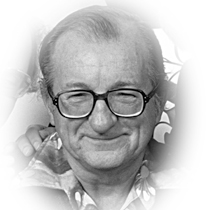
AV: It was also a great musical meeting, with music director Irwin Kostal [above]. Can you tell me about him?
RMS: Musically speaking, we were given the greatest gift of all, a genius, Irwin Kostal, who came from Broadway. He was the musical director of many, many shows on Broadway, and television shows. He knew how to capture the period, the style that we were going for as songwriters. He could capture that in his orchestrations and utilized all of our themes. He understood about carrying the personality by subtly playing the melody. So, Chim Chim Cher-ee became Bert’s theme and Spoonful of Sugar became Mary Poppins’ theme, The Life I Lead Mr. Banks’ theme and Sister Sufragettes Mrs Banks’ theme. It is the cooperation of the music director and ourselves and Walt Disney and Bill Walsh and Don Da Gradi that really made things happen. Then, we had a really fine director, Robert Stevenson, who carried it all together and put it all on the screen. So, it was just a combination of brilliant people all working together. It was a miracle!

AV: How did your association work with Irwin Kostal?
RMS: Irwin was a master orchestrator. He was the one who selected what would be carried by violins or the brass or whatever it would be. The only thing we’ve ever said was for example, in the animated sequence, when the little entertainers with the buttons on their coats, that we wanted that to sound like they’re playing themselves, not a big orchestra. His tour de force, I think, was Step in Time, when they’re changing the words to comment different actions, he just kept mounting and building and building with that little theme and made such a thing out of it. It was a master’s work. He was great!

AV: What are your memories of him as a person?
RMS: He was just a sweet and wonderful guy. He worked very, very diligently and intensely. And he was fast. He could do it like overnight. He’d come in with an incredible arrangement or something. We were impressed. He was a kind, wonderful, talented man. Music was his whole life. He was very special. We did five pictures with him. We did Bedknobs and Broomsticks, Chitty Chitty Bang Bang, Charlotte’s Web and The Magic of Lassie, a wonderful story about Lassie. He was always terrific! All you had to do was say: “Here is a song. You’ll know what to do!” What we did do is that we’d always spot pictures together. We’d see the rough cut of the picture and discuss what we thought would be right for scenes. It was a wonderful give and take with a master musician and a couple of songwriters.

AV: Feed the Birds (Tuppence a Bag) is well-known to be Walt’s favorite song. Do you know why?
RMS: Because, you see, it’s all symbolism. That whole song is a symbolic statement. It has nothing to do with feeding breadcrumbs and buy them for two pennies – tuppence. It has to do with it doesn’t take very much to do a kind, loving deed, to do a kind thought. It takes practically nothing. So, “tuppence” is symbolic of “nothing”. It takes place at St Paul’s Cathedral, which is Christopher Wren’s magnificent cathedral in London, and surrounding the top of the cathedral, all around the roof area are Saints and Apostles. So, we said that the Saints and Apostles look down and they’re smiling when it happens. It’s all symbolism. It says that God and his disciples say it’s a wonderful thing to be kind and to do a good deed: “Although you can’t see it / You know they are smiling / Each time someone shows that he cares”.
It got to Walt. He just loved it because he’s always loved subtlety. He loved to have a double meaning. And the people feel it. It’s not about the woman at all; it’s about being kind. The father was so busy making money and everything than he never showed any real interest in his children. He just was too busy, and he had to realize that it takes nothing. You just have to go down and fix their kite and take them out to fly a kite with them, and you’ll be a real father. Naturally, we were saying it without saying it, and Walt loved it immediately. That was one of the early songs we wrote and we said: “that’s the theme of the whole picture”. It was a very magical, wonderful thing!
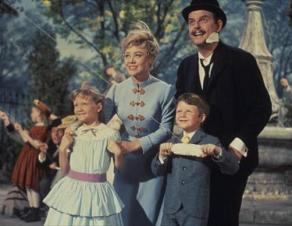
AV: Indeed, your songs are pervaded by Walt Disney’s philosophy.
RMS: There’s a thing called “being on the same wavelength”. We never deliberately tried to write Walt’s philosophy. But we were told that, many times, we were kind of like his musical gurus! Because we did feel the way he did. Take Spoonful of Sugar. Again, we’re not saying: “hey, be happy and hard work will be easy!” We just say: “a spoonful of sugar helps the medicine go down”. You figure out what that means, you know. His philosophy was always: you have a good attitude and the toughest job is gonna be easy, a lot easier. Basically, we were on the same wavelength with Walt all the time. That why we stayed so many years. It was a great wedding of creative minds. Not putting us on the same level with Walt, but at least, we thought the way he did about things and that what was good!
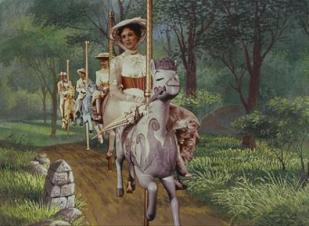
AV: Now, when you look back at Walt’s time, especially the time of such masterpieces as Mary Poppins, how do you remember it?
RMS: It’s always a pleasure to talk about the Disney experience. To us, it was something very, very special. All the things we’ve done subsequent to Disney, it’s always been compared to the things we did at Disney. We were privileged to work with a super-genius. I think, the most brilliant storyteller of the last century – no question about it. He belongs up to Aesop and the Grimm brothers and all the great storytellers. He is just a master.
If we have accomplished anything, it’s in great measure because of Walt’s taste. It was Walt’s baby. When we wrote our book, Walt’s Time, we wanted people to know that we owe so very much to this genius, because he was our launching pad. We were just pop songwriters and he gave us the chance to write musicals, and it was a great, great jump forward for us. My brother Bob and I owe our career to him.





